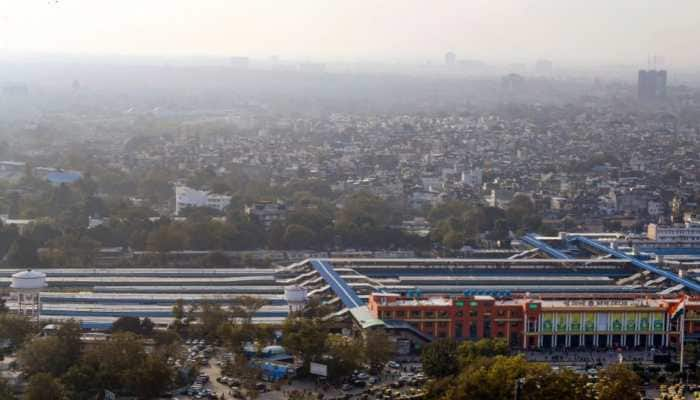RBI cuts repo rate by 0.25% to 7.25%; home, auto loans to become cheaper
EMIs on home and auto loans will come down with SBI and other banks cutting lending rates within hours of RBI Tuesday slashing policy rate by 0.25 percent for the third time this year.
Trending Photos
)
Mumbai: EMIs on home and auto loans will come down with SBI and other banks cutting lending rates within hours of RBI Tuesday slashing policy rate by 0.25 percent for the third time this year.
Reserve Bank Governor Raghuram Rajan, however, cautioned that uncertain monsoon may prevent future rate cuts, an outlook that disappointed markets.
Central bank in its second bi-monthly monetary policy used subdued inflationary condition to "front load" the repo rate cut to 7.25 percent to spur investment and growth, a move that the government as well as India Inc welcomed but stock markets reacted with the largest fall in nearly four weeks.
Responding to the RBI policy action, country's largest lender SBI reduced the lending rate by 0.15 percent to 9.7 percent, while Allahabad Bank and Punjab & Sind Bank cut their base rates by 0.3 percent and 0.25 percent respectively. Others are likely to follow suit.
Rate cut apart, Rajan suggested to the government to prepare 'contingency plans' to deal with the impact of deficient monsoon on food prices.
Hours later, India Meteorological Department (IMD) said the monsoon is likely to be only 88 percent of the normal average or "deficient", triggering fears of drought and adding further uncertainty in the market.
RBI lowered the economic growth forecast for the current fiscal and said last week's high GDP numbers are not reflective of the reality on the ground.
"Even with the 7.5 percent growth numbers, there is some discussion of how much that includes special factors in the last quarter, including excise taxes and subsidy. And so when you subtract that, the growth in the last quarter doesn't look as strong as before," Rajan said.
"And so, you could point to those numbers also suggesting growth is weaker than at least the headline numbers suggest," he added.
RBI cut the repo rate (short-term lending rate) from 7.5 percent to 7.25, but left all other policy tools like cash reserve requirement unchanged at 4 percent and Statutory Liquidity Ratio at 21.5 percent.
The BSE benchmark index Sensex plunged by 661 points, its biggest fall in nearly a month, and rupee went down by 12 paise as RBI took a cautious stance on economic recovery, while forecast of a deficient monsoon added to the rout.
Commenting on RBI policy action, Chief Economic Adviser Arvind Subramanian said the government and RBI agree these cuts signify that the economy needs policy support as growth is recovering while the external environment remains weak.
"The government and the RBI will work together to ensure that the macroeconomic (indicators) remain strong while investment and growth are accelerated towards their potential," he added.
India Inc welcomed the rate cut but said it is still not enough to spur demand and propel industrial growth.
"At least 50 basis points cut in the repo rate was required along with a reduction in the Cash Reserve Ratio (CRR) so that banks are able to reduce their cost of funds," Assocham President Rana Kapoor said.
Rajan said inflation still remains a worry for the central bank as it expects price rise to remain subdued till August before rising to 6 percent by January 2016.
It asked the government to put in place a "contingency plan" to manage the impact of low food production on inflation, mainly because of expected lower than normal rains.
The other concern for the RBI is rising crude oil prices. Since the last policy in April, the crude oil prices have witnessed an increase of 9 percent.
Rajan said that "with low domestic capacity utilisation, still mixed indicators of recovery, and subdued investment and credit growth, there is a case for a cut in the policy rate today".
Commenting on macroeconomic conditions, RBI said, the domestic economic activity remains moderate with agriculture being the most disappointing following the unseasonal rains and hailstorms in the most part of the country in March.
Rajan said however that the risks to inflation identified in April could cloud the picture with below par monsoons forecast for the second successive year.
Rajan said he expects banks to pass on the policy rate cut to individual and corporate borrowers.
"Banks should pass sequence of lending rate cuts," he said.
Reserve Bank Governor Raghuram Rajan, however, cautioned that uncertain monsoon may prevent future rate cuts, an outlook that disappointed markets.
Central bank in its second bi-monthly monetary policy used subdued inflationary condition to "front load" the repo rate cut to 7.25 percent to spur investment and growth, a move that the government as well as India Inc welcomed but stock markets reacted with the largest fall in nearly four weeks.
Responding to the RBI policy action, country's largest lender SBI reduced the lending rate by 0.15 percent to 9.7 percent, while Allahabad Bank and Punjab & Sind Bank cut their base rates by 0.3 percent and 0.25 percent respectively. Others are likely to follow suit.
Rate cut apart, Rajan suggested to the government to prepare 'contingency plans' to deal with the impact of deficient monsoon on food prices.
Hours later, India Meteorological Department (IMD) said the monsoon is likely to be only 88 percent of the normal average or "deficient", triggering fears of drought and adding further uncertainty in the market.
RBI lowered the economic growth forecast for the current fiscal and said last week's high GDP numbers are not reflective of the reality on the ground.
"Even with the 7.5 percent growth numbers, there is some discussion of how much that includes special factors in the last quarter, including excise taxes and subsidy. And so when you subtract that, the growth in the last quarter doesn't look as strong as before," Rajan said.
"And so, you could point to those numbers also suggesting growth is weaker than at least the headline numbers suggest," he added.
RBI cut the repo rate (short-term lending rate) from 7.5 percent to 7.25, but left all other policy tools like cash reserve requirement unchanged at 4 percent and Statutory Liquidity Ratio at 21.5 percent.
The BSE benchmark index Sensex plunged by 661 points, its biggest fall in nearly a month, and rupee went down by 12 paise as RBI took a cautious stance on economic recovery, while forecast of a deficient monsoon added to the rout.
Commenting on RBI policy action, Chief Economic Adviser Arvind Subramanian said the government and RBI agree these cuts signify that the economy needs policy support as growth is recovering while the external environment remains weak.
"The government and the RBI will work together to ensure that the macroeconomic (indicators) remain strong while investment and growth are accelerated towards their potential," he added.
India Inc welcomed the rate cut but said it is still not enough to spur demand and propel industrial growth.
"At least 50 basis points cut in the repo rate was required along with a reduction in the Cash Reserve Ratio (CRR) so that banks are able to reduce their cost of funds," Assocham President Rana Kapoor said.
Rajan said inflation still remains a worry for the central bank as it expects price rise to remain subdued till August before rising to 6 percent by January 2016.
It asked the government to put in place a "contingency plan" to manage the impact of low food production on inflation, mainly because of expected lower than normal rains.
The other concern for the RBI is rising crude oil prices. Since the last policy in April, the crude oil prices have witnessed an increase of 9 percent.
Rajan said that "with low domestic capacity utilisation, still mixed indicators of recovery, and subdued investment and credit growth, there is a case for a cut in the policy rate today".
Commenting on macroeconomic conditions, RBI said, the domestic economic activity remains moderate with agriculture being the most disappointing following the unseasonal rains and hailstorms in the most part of the country in March.
Rajan said however that the risks to inflation identified in April could cloud the picture with below par monsoons forecast for the second successive year.
Rajan said he expects banks to pass on the policy rate cut to individual and corporate borrowers.
"Banks should pass sequence of lending rate cuts," he said.
Will banks pass on the benefit of the cut in policy rates to the borrowers? in Business on LockerDome
Stay informed on all the latest news, real-time breaking news updates, and follow all the important headlines in india news and world News on Zee News.
Advertisement
Live Tv
Advertisement







)
)
)
)
)
)
)
)
)
)
